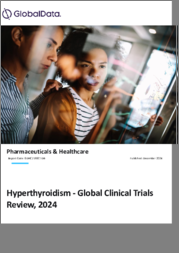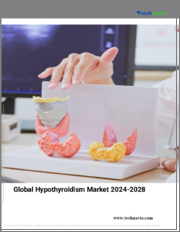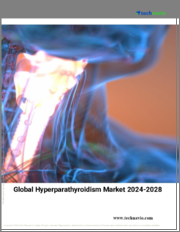
|
시장보고서
상품코드
1560837
세계의 갑상선 질환 치료제 시장(2024-2031년)Global Thyroid Gland Disorders Therapeutics Market - 2024 - 2031 |
||||||
보고서 개요
세계 갑상선 질환 치료제 시장 규모는 2023년 27억 달러에 달했습니다. 2031년에는 43억 달러에 달할 것으로 예상되며, 2024-2031년의 예측 기간 동안 6.3%의 연평균 복합 성장률(CAGR)을 나타낼 것으로 예상됩니다.
갑상선 질환 치료에는 갑상선 기능 저하증, 갑상선 기능 항진증, 갑상선 결절, 갑상선암과 같은 갑상선 기능 이상을 치료하기 위한 의학적 개입이 포함됩니다. 치료에는 호르몬 대체 요법, 항갑상선제, 방사성 요오드, 수술 요법 등이 있습니다. 분자 표적 치료법의 발전으로 치료의 정확도가 향상되어 환자에게 적합한 솔루션을 제공할 수 있게 되었습니다. 이러한 치료는 갑상선 호르몬 생산 장애로 인한 대사 불균형을 해결하기 위한 것입니다.
시장 역학 :
촉진요인과 억제요인
갑상선 질환의 유병률 증가
세계 갑상선 질환 치료제 시장은 갑상선 기능 저하증, 갑상선 기능 항진증, 갑상선 결절, 갑상선암과 같은 갑상선 질환의 유병률 증가로 인해 성장세를 보이고 있습니다. 인구 고령화, 유전적 소인, 하시모토 갑상선염 및 갑상선 질환과 같은 자가면역 질환과 같은 요인이 이러한 증가에 기여하고 있습니다.
예를 들어, 미국 갑상선협회에 따르면 미국 인구의 12% 이상이 갑상선 질환을 앓고 있으며, 200억 명의 미국인이 갑상선 질환을 앓고 있다고 합니다. 갑상선 질환을 앓고 있는 사람의 최대 60%는 자신의 증상을 알지 못합니다. 여성은 남성보다 갑상선 질환에 걸릴 확률이 5-8배 높으며, 여성 8명 중 1명이 갑상선 질환을 앓고 있습니다.
대부분의 갑상선암은 치료에 반응하지만, 일부 갑상선암은 공격성이 있습니다. 진단되지 않은 갑상선 질환은 심혈관 질환, 골다공증, 불임과 같은 심각한 질환으로 이어질 수 있습니다. 갑상선 기능 저하증으로 진단받지 못했거나 제대로 치료받지 못한 임산부는 유산과 조산의 위험이 높습니다.
약물에 따른 합병증
갑상선 질환은 치료법에 따라 다양한 부작용을 초래할 수 있습니다. 갑상선 기능 저하증에 사용되는 호르몬 대체 요법은 체중 증가, 탈모, 심계항진, 불안, 불면증을 유발할 수 있습니다. 메티마졸이나 프로피르티오우라실과 같은 항갑상선제는 간독성, 피부 발진, 관절통, 백혈구 수 감소, 감염의 위험을 증가시킬 수 있습니다. 방사성 요오드 요법은 장기적인 갑상선 기능 저하증으로 이어질 수 있으며, 평생 호르몬 보충이 필요하고, 갈증, 타액선 염증, 미각 변화를 유발할 수 있습니다.
시장 부문 분석
세계 갑상선 질환 치료 시장은 질병 유형, 약물 유형, 투여 경로, 유통 채널 및 지역에 따라 세분화됩니다.
약물 유형별 갑상선 호르몬은 갑상선 질환 치료제 시장 점유율의 약 40.1%를 차지합니다.
갑상선 호르몬은 약 40.1% 시장 점유율을 차지하고 있습니다. 갑상선 호르몬은 갑상선 질환, 특히 갑상선 기능 저하증 치료에 매우 중요합니다. 레보티록신과 같은 호르몬 대체 요법은 갑상선 호르몬의 정상 수준을 회복하고 신진대사와 에너지 수준을 조절하는 데 사용됩니다.
갑상선기능저하증의 유병률 증가와 진단 기술의 발전으로 인해 이러한 치료법에 대한 수요가 증가하고 있습니다. 갑상선 호르몬 수치는 갑상선 기능 항진증, 갑상선 결절 및 갑상선암 치료를 받는 환자에서 모니터링 및 관리되고 있습니다. 평생 치료제로서 갑상선 호르몬 보충에 대한 의존도가 시장 성장에 크게 기여하고 있습니다.
예를 들어, 2023년 12월 FDA는 갑상선기능저하증 치료제인 레보티록신나트륨(Tirosint-SOL, IBSA)의 라벨에 두 가지 변경을 승인했습니다. 첫 번째 변경 사항은 레보티록신 나트륨과 양성자 펌프 억제제(PPI) 요법의 병용요법이며, 두 번째 변경 사항은 레보티록신 나트륨의 투여 시기입니다.
지역별 시장 분석
북미는 예측 기간 동안 전체 시장 점유율의 약 38.4%를 차지할 것으로 추정됩니다.
북미는 유병률 증가, 의료 시설 개선, 일반 대중의 인식, 치료 옵션, 정부 및 제약사의 홍보 전략 등으로 인해 예측 기간 동안 전체 시장의 약 38.4%를 차지할 것으로 추정됩니다.
예를 들어, 2024년 7월 미국 식품의약국(FDA)은 RET라는 유전자에 특정 변화가 있는 2세 이상의 진행성 또는 전이성 갑상선암 성인 및 소아 환자의 치료제로 표적치료제 셀루페르카티닙(레테부모)을 전면 승인했습니다.
목차
제1장 조사 방법과 조사 범위
제2장 정의와 개요
제3장 주요 요약
제4장 시장 역학
- 영향요인
- 성장 촉진요인
- 성장 억제요인
- 기회
- 영향 분석
제5장 산업 분석
- Porter의 Five Forces 분석
- 공급망 분석
- 가격 분석
- 규제 분석
- 특허 분석
- PESTLE 분석
- SWOT 분석
- DMI 의견
제6장 질환 유형별
- 갑상선 기능 저하증
- 갑상선 기능 항진증
- 기타
제7장 약제 클래스별
- Thiourea derivatives
- Propylthiouracil
- Thyroid Hormones
- 전해질
- 부신피질 스테로이드
- 삼환계 항우울제
- 항간질제
제8장 투여 경로별
- 경구
- 비경구
- 기타
제9장 유통 채널별
- 원내 약국
- 소매 약국
- 온라인 약국
제10장 지역별
- 북미
- 미국
- 캐나다
- 멕시코
- 유럽
- 독일
- 영국
- 프랑스
- 이탈리아
- 스페인
- 기타 유럽
- 남미
- 브라질
- 아르헨티나
- 기타 남미
- 아시아태평양
- 중국
- 인도
- 일본
- 한국
- 기타 아시아태평양
- 중동 및 아프리카
제11장 경쟁 구도
- 경쟁 시나리오
- 시장 현황/점유율 분석
- 인수합병(M&A) 분석
제12장 기업 개요
- GlaxoSmithKline PLC
- 기업 개요
- 제품 포트폴리오와 설명
- 재무 개요
- 주요 발전
- Abbvie Inc
- Amgen Inc
- Novartis AG
- Mylan NV
- Merck KGaA
- Pfizer Inc
- Takeda Pharmaceutical Company Limited
- Elexis Inc
- IBSA Pharma(IBSA Group)
제13장 부록
LSH 24.10.16Report Overview
Global Thyroid Gland Disorders Therapeutics Market reached US$ 2.7 billion in 2023 and is expected to reach US$ 4.3 billion by 2031, growing at a CAGR of 6.3% during the forecast period 2024-2031
Thyroid gland disorders therapeutics involve medical interventions to treat abnormalities in thyroid function, such as hypothyroidism, hyperthyroidism, thyroid nodules, and thyroid cancer. Treatments include hormone replacement therapy, antithyroid medications, radioactive iodine, and surgical options. Advancements in molecular and targeted therapies improve treatment precision, providing more tailored solutions for patients. These treatments address metabolic imbalances caused by disrupted thyroid hormone production.
Market Dynamics: Drivers & Restraints
Rise in the prevalence of thyroid disorders
The global thyroid gland disorders therapeutics market is experiencing growth due to the increasing prevalence of thyroid disorders like hypothyroidism, hyperthyroidism, thyroid nodules, and thyroid cancer. Factors like aging populations, genetic predispositions, and autoimmune diseases like Hashimoto's thyroiditis and Graves' disease are contributing to this increase.
For instance, according to America Thyroid Association, over 12 percent of the U.S. population will develop a thyroid condition, with 20 Billion Americans having some form of thyroid disease. Up to 60% of those with thyroid disease are unaware of their condition. Women are five to eight times more likely than men to have thyroid problems. One woman in eight will develop a thyroid disorder.
Most thyroid cancers respond to treatment, but a small percentage can be aggressive. Undiagnosed thyroid disease can lead to serious conditions like cardiovascular diseases, osteoporosis, and infertility. Pregnant women with undiagnosed or inadequately treated hypothyroidism have an increased risk of miscarriage and preterm delivery.
Complications associated with the drugs
Thyroid gland disorders can result in various side effects, depending on the treatment. Hormone replacement therapy, used in hypothyroidism, can cause weight gain, hair loss, heart palpitations, anxiety, and insomnia. Antithyroid medications, like methimazole and propylthiouracil, can cause liver toxicity, skin rashes, joint pain, and reduced white blood cell counts, increasing the risk of infections. Radioactive iodine therapy can lead to long-term hypothyroidism, requiring lifelong hormone replacement, and may cause dry mouth, salivary gland inflammation, or taste changes.
Market Segment Analysis
The global thyroid gland disorders therapeutics market is segmented based on disease type, drug class, route of administration, distribution channel, and region.
The thyroid hormones from the drug class segment accounted for approximately 40.1% of the thyroid gland disorders therapeutics market share
The thyroid hormones from the drug class segment accounted for approximately 40.1%. Thyroid hormones are crucial in treating thyroid disorders, especially hypothyroidism. Hormone replacement therapies like levothyroxine are used to restore normal levels of thyroid hormones, regulating metabolism and energy levels.
The increasing prevalence of hypothyroidism and improved diagnostic techniques have driven demand for these therapies. Thyroid hormone levels are monitored and managed in patients undergoing treatments for hyperthyroidism, nodules, and thyroid cancer. The reliance on thyroid hormone replacement as a lifelong treatment contributes significantly to market growth.
For instance, in December 2023, the FDA approved 2 changes to the label of levothyroxine sodium (Tirosint-SOL, IBSA), an oral solution that is aimed to treat hypothyroidism. The first change included the use of levothyroxine sodium combined with proton pump inhibitor (PPI) therapy. The second change included timing to administer levothyroxine sodium.
Market Geographical Analysis
North America is estimated to hold about 38.4% of the total market share throughout the forecast period
North America is estimated to hold about 38.4% of the total market share throughout the forecast period due to increased prevalence, improved healthcare facilities, public awareness, and treatment options, as well as promotional strategies between governments and pharmaceutical companies.
For instance, in July 2024, the US Food and Drug Administration (FDA) granted full approval to the targeted therapy selpercatinib (Retevmo) for treating adult and pediatric patients 2 years and older with advanced or metastatic thyroid cancers that have certain changes in a gene called RET.
Market Segmentation
By Disease Type
Hypothyroidism
Hyperthyroidism
Others
By Drug Class
Thiourea derivatives
Propylthiouracil
Methimazole
Beta-adrenergic blocking agents
Propranolol
Others
Thyroid Hormones
Levothyroxine
Liothyronine
Others
Electrolytes
Potassium chloride
Others
Corticosteroids
Prednisone
Others
Tricyclic antidepressants
Amitriptyline
Others
Antiepileptic agents
Gabapentin
Others
By Route of Administration
Oral
Parenteral
Others
By Distribution Channel
Hospital Pharmacies
Retail Pharmacies
Online Pharmacies
By Region
North America
U.S.
Canada
Mexico
Europe
Germany
UK
France
Italy
Spain
Rest of Europe
South America
Brazil
Argentina
Rest of South America
Asia-Pacific
China
India
Japan
South Korea
Rest of Asia-Pacific
Middle East and Africa
Market Competitive Landscape
The major global players in the market include GlaxoSmithKline PLC, Abbvie Inc,Amgen Inc, Novartis AG, Mylan NV, Merck KGaA, Pfizer Inc, Takeda Pharmaceutical Company Limited, Elexis Inc, IBSA Pharma (IBSA Group) among others.
Key Developments
In May 2023, Merck KGaA collaborated with the Executive Board of the Indonesian Medical Association and the Central Board of the Indonesian Thyroid Association to improve screening and diagnosis of thyroid disorders in Indonesia.
In December 2023, Aspen Pharmacare Holdings Limited made an agreement with Sandoz AG to acquire its Chinese business, helping to expand its presence in China by establishing a portfolio for future growth in the region.
Why Purchase the Report?
To visualize the global thyroid gland disorders therapeutics market segmentation based on disease type, drug class, route of administration, distribution channel, and region as well as understand key commercial assets and players.
Identify commercial opportunities by analyzing trends and co-development.
Excel data sheet with numerous data points of the thyroid gland disorders therapeutics market level with all segments.
PDF report consists of a comprehensive analysis after exhaustive qualitative interviews and an in-depth study.
Product mapping available as excel consisting of key products of all the major players.
The global thyroid gland disorders therapeutics market report would provide approximately 64 tables, 61 figures, and 186 pages.
Target Audience 2024
Manufacturers/ Buyers
Industry Investors/Investment Bankers
Research Professionals
Emerging Companies
Table of Contents
1. Methodology and Scope
- 1.1. Research Methodology
- 1.2. Research Objective and Scope of the Report
2. Definition and Overview
3. Executive Summary
- 3.1. Snippet by Disease Type
- 3.2. Snippet by Drug Class
- 3.3. Snippet by Route of Administration
- 3.4. Snippet by Distribution Channel
- 3.5. Snippet by Region
4. Dynamics
- 4.1. Impacting Factors
- 4.1.1. Drivers
- 4.1.1.1. Rise in the prevalence of thyroid disorders
- 4.1.1.2. Rise in the research and development
- 4.1.2. Restraints
- 4.1.2.1. Complications associated with the drugs
- 4.1.3. Opportunity
- 4.1.4. Impact Analysis
- 4.1.1. Drivers
5. Industry Analysis
- 5.1. Porter's Five Force Analysis
- 5.2. Supply Chain Analysis
- 5.3. Pricing Analysis
- 5.4. Regulatory Analysis
- 5.5. Patent Analysis
- 5.6. PESTLE Analysis
- 5.7. SWOT Analysis
- 5.8. DMI Opinion
6. By Disease Type
- 6.1. Introduction
- 6.1.1. Market Size Analysis and Y-o-Y Growth Analysis (%), By Disease Type
- 6.1.2. Market Attractiveness Index, By Disease Type
- 6.2. Hypothyroidism*
- 6.2.1. Introduction
- 6.3. Hyperthyroidism
- 6.4. Others
7. By Drug Class
- 7.1. Introduction
- 7.1.1. Market Size Analysis and Y-o-Y Growth Analysis (%), By Drug Class
- 7.2. Market Attractiveness Index, By Drug Class
- 7.3. Thiourea derivatives*
- 7.3.1. Introduction
- 7.3.2. Market Size Analysis and Y-o-Y Growth Analysis (%)
- 7.4. Propylthiouracil
- 7.5. Thyroid Hormones
- 7.6. Electrolytes
- 7.7. Corticosteroids
- 7.8. Tricyclic antidepressants
- 7.9. Antiepileptic agents
8. By Route of Administration
- 8.1. Introduction
- 8.1.1. Market Size Analysis and Y-o-Y Growth Analysis (%), By Route of Administration
- 8.1.2. Market Attractiveness Index, By Route of Administration
- 8.2. Oral*
- 8.2.1. Introduction
- 8.2.2. Market Size Analysis and Y-o-Y Growth Analysis (%)
- 8.3. Parenteral
- 8.4. Others
9. By Distribution Channel
- 9.1. Introduction
- 9.1.1. Market Size Analysis and Y-o-Y Growth Analysis (%), By Distribution Channel
- 9.1.2. Market Attractiveness Index, By Distribution Channel
- 9.2. Hospital Pharmacies*
- 9.2.1. Introduction
- 9.2.2. Market Size Analysis and Y-o-Y Growth Analysis (%)
- 9.3. Retail Pharmacies
- 9.4. Online Pharmacies
10. By Region
- 10.1. Introduction
- 10.1.1. Market Size Analysis and Y-o-Y Growth Analysis (%), By Region
- 10.1.2. Market Attractiveness Index, By Region
- 10.2. North America
- 10.2.1. Introduction
- 10.2.2. Key Region-Specific Dynamics
- 10.2.3. Market Size Analysis and Y-o-Y Growth Analysis (%), By Disease Type
- 10.2.4. Market Size Analysis and Y-o-Y Growth Analysis (%), By Drug Class
- 10.2.5. Market Size Analysis and Y-o-Y Growth Analysis (%), By Route of Administration
- 10.2.6. Market Size Analysis and Y-o-Y Growth Analysis (%), By Distribution Channel
- 10.2.7. Market Size Analysis and Y-o-Y Growth Analysis (%), By Country
- 10.2.7.1. U.S.
- 10.2.7.2. Canada
- 10.2.7.3. Mexico
- 10.3. Europe
- 10.3.1. Introduction
- 10.3.2. Key Region-Specific Dynamics
- 10.3.3. Market Size Analysis and Y-o-Y Growth Analysis (%), By Disease Type
- 10.3.4. Market Size Analysis and Y-o-Y Growth Analysis (%), By Drug Class
- 10.3.5. Market Size Analysis and Y-o-Y Growth Analysis (%), By Route of Administration
- 10.3.6. Market Size Analysis and Y-o-Y Growth Analysis (%), By Distribution Channel
- 10.3.7. Market Size Analysis and Y-o-Y Growth Analysis (%), By Country
- 10.3.7.1. Germany
- 10.3.7.2. UK
- 10.3.7.3. France
- 10.3.7.4. Italy
- 10.3.7.5. Spain
- 10.3.7.6. Rest of Europe
- 10.4. South America
- 10.4.1. Introduction
- 10.4.2. Key Region-Specific Dynamics
- 10.4.3. Market Size Analysis and Y-o-Y Growth Analysis (%), By Disease Type
- 10.4.4. Market Size Analysis and Y-o-Y Growth Analysis (%), By Drug Class
- 10.4.5. Market Size Analysis and Y-o-Y Growth Analysis (%), By Route of Administration
- 10.4.6. Market Size Analysis and Y-o-Y Growth Analysis (%), By Distribution Channel
- 10.4.7. Market Size Analysis and Y-o-Y Growth Analysis (%), By Country
- 10.4.7.1. Brazil
- 10.4.7.2. Argentina
- 10.4.7.3. Rest of South America
- 10.5. Asia-Pacific
- 10.5.1. Introduction
- 10.5.2. Key Region-Specific Dynamics
- 10.5.3. Market Size Analysis and Y-o-Y Growth Analysis (%), By Disease Type
- 10.5.4. Market Size Analysis and Y-o-Y Growth Analysis (%), By Drug Class
- 10.5.5. Market Size Analysis and Y-o-Y Growth Analysis (%), By Route of Administration
- 10.5.6. Market Size Analysis and Y-o-Y Growth Analysis (%), By Distribution Channel
- 10.5.7. Market Size Analysis and Y-o-Y Growth Analysis (%), By Country
- 10.5.7.1. China
- 10.5.7.2. India
- 10.5.7.3. Japan
- 10.5.7.4. South Korea
- 10.5.7.5. Rest of Asia-Pacific
- 10.6. Middle East and Africa
- 10.6.1. Introduction
- 10.6.2. Key Region-Specific Dynamics
- 10.6.3. Market Size Analysis and Y-o-Y Growth Analysis (%), By Disease Type
- 10.6.4. Market Size Analysis and Y-o-Y Growth Analysis (%), By Drug Class
- 10.6.5. Market Size Analysis and Y-o-Y Growth Analysis (%), By Route of Administration
- 10.6.6. Market Size Analysis and Y-o-Y Growth Analysis (%), By Distribution Channel
11. Competitive Landscape
- 11.1. Competitive Scenario
- 11.2. Market Positioning/Share Analysis
- 11.3. Mergers and Acquisitions Analysis
12. Company Profiles
- 12.1. GlaxoSmithKline PLC *
- 12.1.1. Company Overview
- 12.1.2. Product Portfolio and Description
- 12.1.3. Financial Overview
- 12.1.4. Key Developments
- 12.2. Abbvie Inc
- 12.3. Amgen Inc
- 12.4. Novartis AG
- 12.5. Mylan NV
- 12.6. Merck KGaA
- 12.7. Pfizer Inc
- 12.8. Takeda Pharmaceutical Company Limited
- 12.9. Elexis Inc
- 12.10. IBSA Pharma (IBSA Group) (*LIST NOT EXHAUSTIVE)
13. Appendix
- 13.1. About Us and Services
- 13.2. Contact Us

















